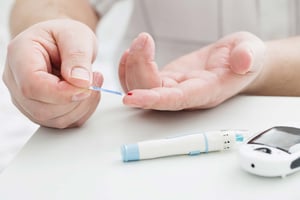Since November is National Diabetes Month, we're exploring topics on this disease which currently effects nearly 30.3 million Americans. This second blog discusses the differences between Type 1 and Type 2 Diabetes.
What is Type 1 Diabetes?
Type 1 Diabetes, which usually develops in people ages 40 and under, occurs because the pancreas is unable to produce sufficient amounts of insulin to lower and control a person’s blood sugar. Type 1 diabetes, which accounts for about 10% of people diagnosed with diabetes, has three common symptoms known as the three P's:
- Polyphagia: Increased eating because the body’s cells, despite the blood sugar level being elevated, doesn't realize this because of the deficiency of insulin. Insulin is a carrier protein that attaches to glucose to allow it to enter the cell wall or membrane to provide the cells with the necessary fuel or energy so the cells can perform their functions.
- Polydipsia: Increased thirst because the elevated glucose in the bloodstream triggers the osmoreceptors in the brain, which stimulates the thirst center in the hypothalamus. As a result, the person responds by increasing their fluid intake in an effort to dilute the excess glucose in an attempt to attain homeostasis.
- Polyuria: Increased urination because once the level of glucose in one’s blood is around 160-180 mg/dL, the kidneys recognize this and increase urination as a means to rid the glucose from the body in an attempt to lower blood sugar levels.

Despite polyphagia, people with Type 1 Diabetes are usually underweight due to the fact that the cells are actually starving because they're dependent on insulin to function properly. Those who suffer from Type 1 Diabetes must take insulin to manage this since their internal source of insulin is inadequate or nonexistent. Sometimes this may be averted through an islet cell or a pancreas transplant.
What is Type 2 Diabetes?
Type 2 Diabetes usually occurs in people ages 45 and over. It occurs because the pancreas is unable to produce sufficient amounts of insulin to lower and control a person’s blood sugar, or because of a decreased sensitivity to the insulin that is present. People with Type 2 Diabetes are usually overweight or obese, and therefore have a higher than desired body mass index (BMI). It is the predominant type of diabetes and accounts for 90% of people with this impairment in glucose metabolism.
With the exception of hyperglycemia, people with Type 2 Diabetes may also experience the following symptoms:
- Delayed wound healing
- Fatigue (i.e. excessive tiredness)
- Recurrent infections (i.e. fungal infections)
- Visual changes (i.e. blurriness)
Sustained elevation of blood sugar levels is known to cause damage to the body’s blood vessels, particularly the arteries. It can also effect the nerves in the nervous system which can lead to a type of nerve pain known as diabetic neuropathy.

Management of Type 2 Diabetes includes achieving and maintaining one’s ideal body weight (IBW). This is not easy as it requires motivation and a desire to change one’s lifestyle or habits. This includes becoming more knowledgeable about selecting healthy foods, preparing these foods to maximize their nutritional value, limiting intake of concentrated sweets (i.e. junk food), and at least 30 minutes of regular exercise at least five days a week. Research has demonstrated that losing 10-15 pounds changes the receptors on the outside of the cell membrane so that the insulin can attach to the glucose more effectively in order to be able to enter the cell membrane and furnish the cell with the fuel source. Despite changes in diet, exercise, and the addition of medications other than insulin, 25% of adults eventually will need insulin to manage their diabetes later in life.
Where Can I Find More Information On Diabetes?
The American Diabetes Association is an excellent source of information to learn more about this chronic condition. They cover topics including how to know if you could be suffering from diabetes, how to live with this condition, food and fitness management, research & practice, way to give, and more.
If you’re interested in a career in the healthcare field, perhaps you should consider becoming a nurse. Currently, Hocking College in Nelsonville, Ohio offers both a Registered Nursing program and a PN2RN transition program.
For more information on any of these programs, contact the Hocking College Admissions Office at (740) 753-7050.



